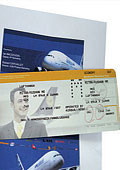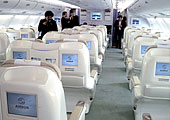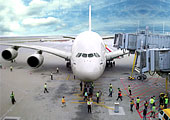9.30 A.M.-6.00 P.M., MARCH 24, 2007
Hong Kong International Airport
An
aviation junkie like me shouldn't be saying this, but I am getting
a bit tired waiting for the big moment. I have been at the Chek
Lap Kok airport since half past nine in the morning for what was
supposed to be a 1 p.m. boarding for a ride that had got me all
excited just a few days ago-a two-hour, "route proving"
joy ride over Hong Kong on board Airbus' newest baby, the A380.
Around 2 p.m., I-and 75 other journos who've been flown in from
all over Asia-am told that the flight from Frankfurt is delayed
by two hours, so the boarding will commence at 3 p.m.
 I
hang around, chat with a few scribes, and just when I feel like
plonking myself down on a quiet chair somewhere away from my boarding
gate No. 62, I get the word that the eagle has landed. And one
look at it is all it takes to melt away my hours of grumbling.
It seems my trip will turn out to be interesting after all. I
hang around, chat with a few scribes, and just when I feel like
plonking myself down on a quiet chair somewhere away from my boarding
gate No. 62, I get the word that the eagle has landed. And one
look at it is all it takes to melt away my hours of grumbling.
It seems my trip will turn out to be interesting after all.
When Airbus launched the A380 in a gala ceremony
almost two years ago, some American commentators dubbed it the
'Whale Jet' as opposed to the Boeing 747 'Jumbo Jet'. And just
as Boeing was irritated initially with the Jumbo Jet tag, Airbus
officials countered the whale moniker with a barrage, accusing
the Americans, in essence, of jealousy. But when you see the A380
up close, you suddenly find yourself at a loss for adjectives-behemoth,
leviathan, gargantuan, monstrous, humungous, all adjectives seem
too small. However, it is when you board the plane that you realise
the enormousness of it. It weighs 277,000 kilos when empty, can
seat a total of 549 passengers (that's over 100 rows), and can
carry 80 tonnes of cargo. Its maximum take-off weight: an astonishing
590,000 kilos.
 |
 |
|
Big is too small a word for the A380: You'll be
never short of space in business class (left) or first class
|
Here's the thing, though. Despite its size,
the A380 didn't seem big from the inside-heck, even the toilets
were the regular airline size. Lufthansa, our host during the
flight, kept reminding me that the interiors on this aircraft
were made to Airbus' specifications and not to the German airline's.
But the massive fuselage of the plane does give it an advantage:
the economy seats (in a 2-4-2 configuration on the upper deck
and a 3-4-3 on the lower deck) are almost an inch wider than typical
coach seats. The wide staircase is also a step up on the narrow
staircase on the Boeing 747 and in the way Airbus had set the
plane up, there were even a couple of 'lobby' areas, a standing
bar area in the first-class zone and what one could describe as
a 'lounge' area in the crown of the aircraft next to the staircase
and ahead of the business class seats-quite a nice touch and hopefully
something operators will retain.
| THE A380 BY THE NUMBERS |
Length :
73 metres (that's 21 Maruti 800s parked nose-to-tail)
Wingspan : 79.8 metres
Height :
24.1 metres (as high as the average five-storey building)
Passenger capacity (in a typical 3-class
configuration): 549-555
Passenger capacity (in low-cost,
one-class configuration): 853
Maximum take-off weight :
590,000 kg
Maximum Range : 14,300
km (approximately the distance between Delhi and San Francisco)
Number of planes ordered :
157 (including one unidentified VIP customer who wants the
biggest, baddest business jet money can buy)
Will you see one in India? Kingfisher's
Vijay Mallya has ordered five (deliveries around 2010), but
chances are that Lufthansa will bring in this monster in the
India-Germany route in 2009-10 |
However, while one appreciates the level of
engineering that went into this plane (there's 530 km of wiring
inside the plane, and as if that weren't complicated enough, French
and German engineers inadvertently used two different versions
of software, delaying the aircraft's launch by almost two years),
I could not describe the A380 as elegant. From the outside it
just looked ungainly, and not nearly as pretty as the Boeing 747,
which has a sharply raked nose and wings. I can't exactly describe
the 747 as a quiet plane, but the A380 seemed eerily quiet during
take-off and flight. "It's an easy plane to fly," Captain
Jacques Rosay, Airbus' Chief Test Pilot, and the man who flew
the plane on its maiden flight, told me when I popped into the
cockpit to check it out.
Within the next two years, many hundreds
of you would have flown on this aircraft, because airlines like
Lufthansa do eventually plan to fly them to India, and the sight
of the squat A380 should become as common as the 747 around world
airports. In fact, I would go as far as to say that in the A380
I saw the future of air travel-it is going to be big. I just hope
that no low-cost carrier ever decides to make one of these into
an 800-seat cattle express.
If you want to catch a glimpse of the aircraft,
there will be the Paris Air Show later on the year at Le Bourget.
But a little bird from Airbus told me that the company has 'plans'
of bringing one of the aircraft to India later in 2007 before
delivery of the first plane to Singapore Airlines, scheduled for
October 2007. But for an A380 to land in India, we will need to
have an airport capable of handling it.
|






 I
hang around, chat with a few scribes, and just when I feel like
plonking myself down on a quiet chair somewhere away from my boarding
gate No. 62, I get the word that the eagle has landed. And one
look at it is all it takes to melt away my hours of grumbling.
It seems my trip will turn out to be interesting after all.
I
hang around, chat with a few scribes, and just when I feel like
plonking myself down on a quiet chair somewhere away from my boarding
gate No. 62, I get the word that the eagle has landed. And one
look at it is all it takes to melt away my hours of grumbling.
It seems my trip will turn out to be interesting after all. 
